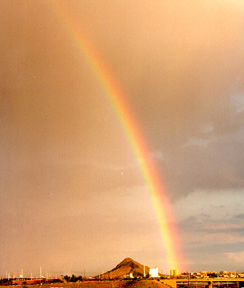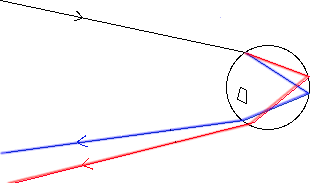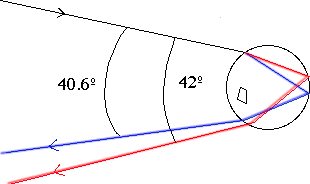Submodule 4: Rainbows Page 2
Steve Beeson, Arizona State University

Did you try making a rainbow with the water-filled flask? If you haven't, please attempt this exercise now.
If you have tried, but you couldn't make a rainbow, think about what the water can do besides refract light. What is the white posterboard used for?
If you have figured it out, why did the rainbow appear where it did?
Think back for a second to the last time you saw a rainbow. Where were you standing relative to the sun? Were you looking toward the sun or away from it?
Most likely away from it.
In fact, it was directly behind you, as you looked at the rainbow. And the rain was probably somewhere in front of you.
So the light must have been bouncing off the raindrops and reflecting back into your eye.
OK, the sun was reflecting off the raindrops.....but why do we see colors?
The colors are present because the sun is not only reflecting off the raindrops, it is also refracting

Notice in the drawing how the raindrop acts like a prism, splitting the white light from the sun (on the left) into it's component colors. For simplification, I have only shown the red and the blue beams.
But notice also how the raindrop acts like a mirror, in that it reflects (some of) the refracted light back toward the sun. These refracted rays are the ones that you see as a rainbow.
When the white light from the sun hits the raindrop, the light is first refracted as it enters the raindrop, much like we observed in Submodule 2 with the prisms. The separate colors are then reflected from the backside of the raindrop and exit, where they refract once again, due to the change of index of refraction between the water and the air.
The angles at which each color emerges is obviously different (or else you wouldn't see different colors!): red light emerges at 42� and blue light emerges at 40.6� relative to the incoming ray of sunlight.

Each raindrop contributes only one color to the rainbow that you see.
...But wait, we saw in the experiment that one raindrop can show the whole spectrum! How can a raindrop contribute only one color to the real rainbow? Let's "reflect" on this a little further.
 Modules
Modules
 Light & Optics
Light & Optics
 Submodule 4
Submodule 4
 Readings
Readings
 PiN Homepage
PiN Homepage
 ACEPT
ACEPT
 Glossary
Glossary
 Help
Help